The following animals have eight letters in their name, at least in modern languages. Read on for more information about these eight-letter animals.

1. Mackerel
Mackerels are fish prized for the table and for sport (if one of the larger species). Members of the Scombridae family, they are torpedo-shaped fish with a forked or crescent-shaped tail. Mackerels have two dorsal fins and two or three pairs of keels on their tail. These keels, along with their tiny scales, wavy stripes, and iridescent bodies, give the fish an especially elegant look.

The king mackerel makes a great fighting fish.
©Coastal Girl/Shutterstock.com
Like their cousins the tuna fish, some species of mackerel can fold their fins into slots in their body to make them even more hydrodynamic. Mackerel are found all over the world and range in size from the king mackerel, which can grow longer than 5 feet and weigh as much as 100 pounds, to the island mackerel, which usually weighs less than two pounds and doesn’t grow much more than 7.8 inches.
Behavior and Reproduction
These eight-letter animals are voracious predators with sharp teeth that can easily handle crustaceans, squid, and smaller fish. In turn, mackerel are hunted by larger animals, including large mackerels and humans. They swim in schools and some species, such as the Chilean jack mackerel, are easy to catch. Indeed, this species is so easy to catch that it has become overfished. Mackerels are migratory, and they move seasonally from one area of the ocean to feed or breed. Some mackerels even migrate vertically, spending the day in deep waters, before rising to shallower waters to feed at night.
A female mackerel can deposit as many as 1,500,000 eggs into the water during the breeding season. These eggs float on the surface of the ocean and become part of the zooplankton, which is part of the diet of animals as large as whale sharks. A mackerel can live as long as 20 years in the wild and is ready to spawn when it’s two to three years old.
2. Capybara
The largest rodent on earth, people love the capybara for its utterly laid-back attitude. It loves water! In fact, at one point, the Vatican erroneously designated it as a fish, which means it can be eaten on Fridays. There are two species in its Hydrochoerus genus. They are the greater capybara, H. hydrochaeris, and the lesser capybara, H. isthmius.
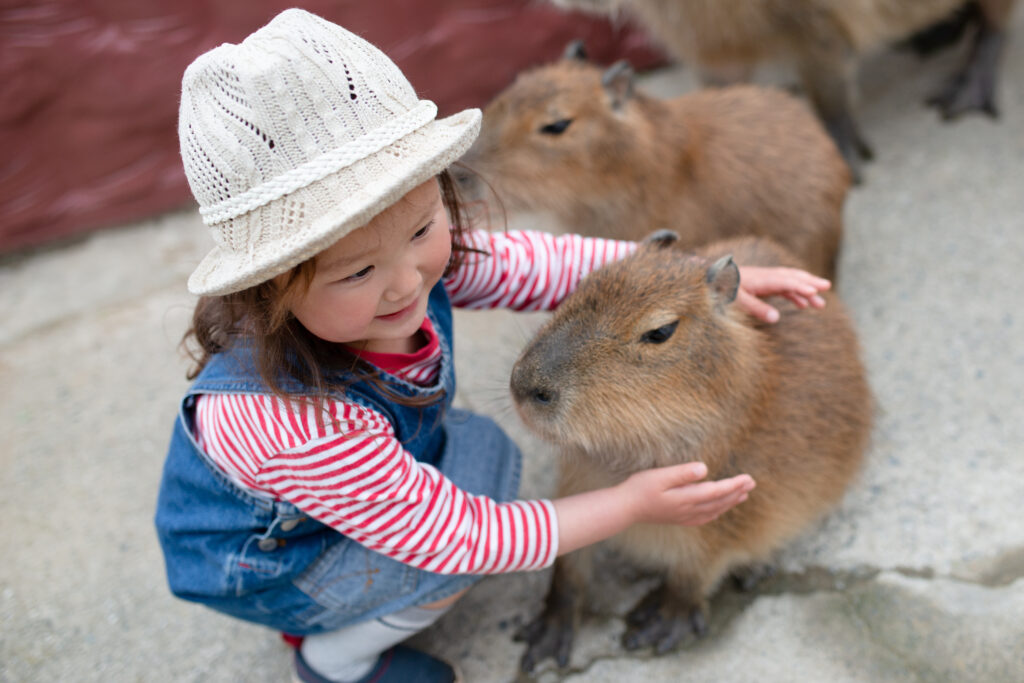
This eight-letter animal is a rather laid-back rodent.
©iStock.com/Hakase_
The capybara, a close cousin of the guinea pig, is native to South America. It’s a social animal that lives in groups. The usual number is about 10 to 20 capybaras, but groups of 100 have been seen in the dry season. The animal does indeed look like an enormous guinea pig with russet fur and a yellow-brown belly, a short snout, short legs, and feet that are slightly webbed. The back feet have three toes, and the front feet have four toes. Their eyes and nostrils are at the top of the head so the animal can comfortably submerge most of its body in the water.
Capybaras grow between 3.48 and 4.40 feet long and weigh between 77 and 146 pounds. Females are heavier than males. They have a scent gland on top of their nose called a morillo, which is bigger in the male.
What They Eat, How They Reproduce
Capybaras live in forests but are always near a body of water. They’re herbivores and can be seen grazing on grass when they’re out of the water or eating aquatic plants when they’re in the water. They eat their own feces to help them digest their food and chew their cud like cows. Because they are rodents their teeth grow all the time, and chewing on tough grasses and bark helps keep the teeth of manageable size. These eight-letter animals can’t make their own vitamin C, and those kept in zoos must have vitamin C supplementation to prevent scurvy.
Capybaras only mate in the water, so if a female isn’t interested in a suitor, she’ll dive or leave the water altogether. Females are pregnant for between 130 and 150 days and usually have a litter of four pups. Capybaras give birth on land, and the pups join the larger group as soon as they are able. They’re weaned when they’re about four months old but can eat grass when they’re only a week old. They form subgroups of juveniles within the larger family.
Despite being a fairly large animal, a capybara only lives between eight and 10 years. Many live shorter lives because of predation from jaguars and green anacondas. Humans eat capybara meat, make leather out of its hide, and use its skin to make grease.
3. Viscacha
The viscacha, or vizcacha, is another rodent that’s found in South America. It looks very much like a rabbit, with thick, soft fur and long ears, but it also has a long tail. It is actually in the same family as the chinchilla but belongs to two genera. They are Lagidium and Lagostomus. There are five viscacha species and all but one belong to the Lagidium genus. Viscachas are between 12 and 26 inches long with tails between 6 and 16 inches long, and weigh between two and five pounds.
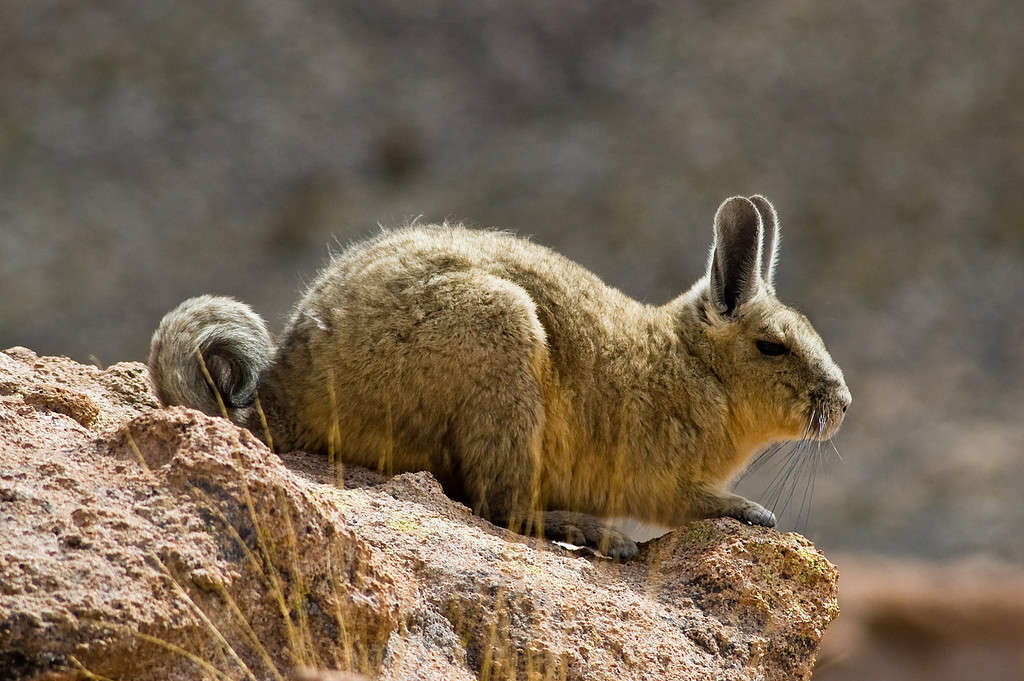
The viscacha looks like a rabbit with a long tail.
©Alexandre Buisse (Nattfodd)/CC BY-SA 3.0 – Original / License
The plains viscacha lives in Argentina’s brushland and Pampas and has a black band across its face. This band makes the animal look like it’s wearing a mustache. It lives in colonies of 20 to 50 individuals and feeds at night. Because it damages grasslands, farmers consider it a pest.
You’ll find the northern viscachas in the Andes of Peru. The southern, or mountain, viscacha is similar to the northern, but its fur is more reddish. There’s also the rare Wolffsohn’s viscacha, which is found in Chile and Argentina as high as 13,000 feet in the mountains. Lagidium ahuacaense is a new species of viscacha, which was described in 2009. It is only found in Cierro El Ahuaca in Ecuador. Because biologists believe only a handful of these rodents remain, L. ahuacaense is considered critically endangered.
4. Bontebok
The bontebok is an antelope found in the scrublands of South Africa, Namibia, and Lesotho and is considered the continent’s rarest antelope. This oddly beautiful animal has a sleek coat that’s an interesting purplish brown. It has a pure white belly, a white blaze from its forehead to its nose, a white patch on its rump, and white stockings. It also has a short, tufted tail. Its horns are mostly ringed and shaped like a lyre. Both sexes have horns. Males spar with theirs to claim territory, but this rarely results in bloodshed.
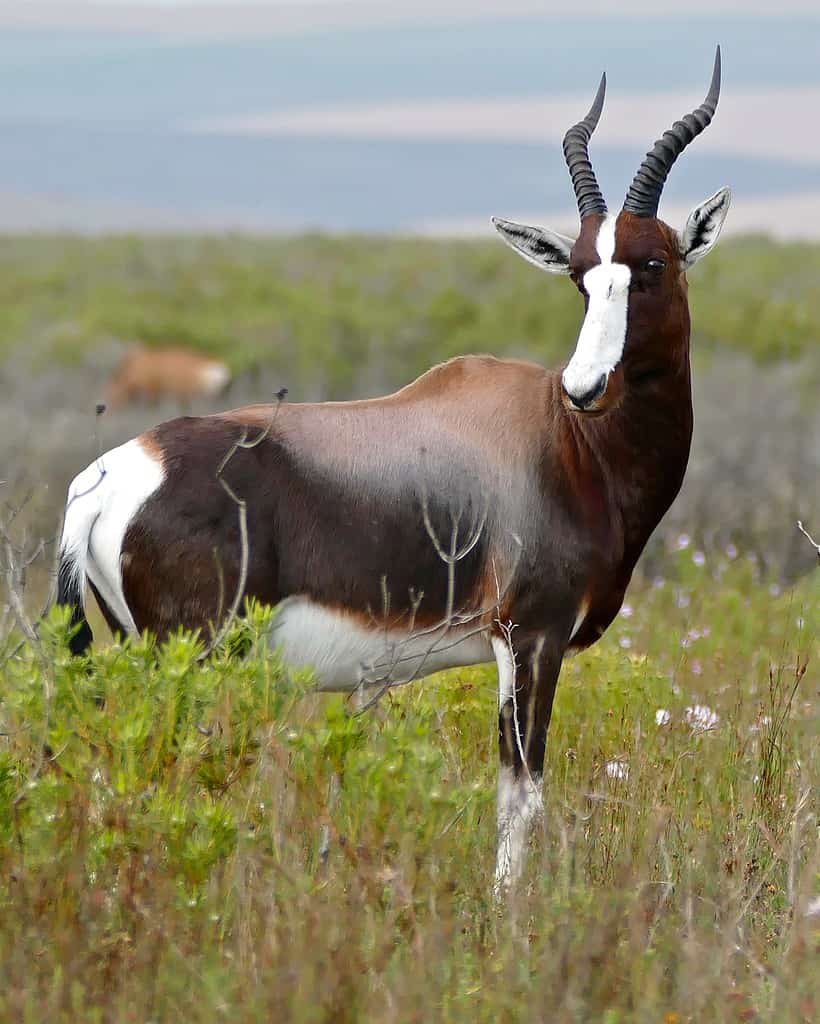
This beautiful antelope is the rarest antelope in
Africa
.
©Bernard DUPONT from FRANCE/ CC BY-SA 2.0 – Original / License
These eight-letter animals stand between 31 to 39 inches at the shoulder, are from 4 to 7 feet long, and weigh between 150 to 340 pounds. Males are a little bigger and significantly heavier. The bontebok is sometimes called the blesbok, even though the blesbok and bontebok are quite different antelopes.
This antelope almost went extinct by the 19th century, as farmers considered it a pest. By the start of the 20th century, there were only 17 individuals left. Now there are about 2,500 to 3,000 animals, all descended from these 17 antelopes. The animal is actually considered extinct in the wild. At the same time, the bontebok’s conservation status is vulnerable. You can find herds of all males, all females or mixed on wildlife preserves. The mating season is in February, and the female is pregnant for about eight months before she gives birth to a single young. The baby is able to walk within two hours of its birth and can live as long as 23 years.
5. Mangabey
Mangabeys are monkeys that are native to West Africa. There are three genera of these eight-letter animals.

The collared mangabey is native to West Africa.
©iStock.com/Ian Peter Morton
- Lophocebus
- Rungwecebus
- Cercocebus
The Lophocebus genus contains the crested mangabeys. They have dark facial skin and eyelids. This animal gets its name due to the crest of hair on top of their heads. There are six species of Lophocebus mangabeys. They’re the grey-cheeked, found from Cameroon down to Gabon; the black-crested, found in the Democratic Republic of the Congo and Angola; Opdenbosch’s, found in DRC; Uganda, found in Uganda; and Johnston’s, found in the DRC, Burundi, and Rwanda. Osman Hill’s is found from Nigeria to Southeastern Cameroon.
There’s only one species of mangabey in the Rungwecebus genus: the highland mangabey or the kipunji. It differs from other mangabeys in the nature of its call, which is sort of a honking barking sound as opposed to the gobble and whoop made by the grey-cheeked or black-crested mangabeys. Male kipunjis are between 33.46 and 35.43 inches long, excluding their tail, and weigh between 22 and 35 pounds. The monkey’s tail is longer than its body, and the animal usually carries it curled up. Kipunjis have long, light brown fur that keeps them warm in the forests where they live. This mangabey’s conservation status is endangered.
The Cercocebus mangabeys are also called white-eyelid mangabeys. Unlike the Lophocebus mangabeys, their upper eyelids are bare and lighter than the skin of their faces. There are seven species of Cercocebus mangabeys: sooty, collared, agile, golden-bellied, Tana River, Sanje, and white-naped.
6. Babirusa
The babirusa is a type of pig that’s found in forests and canebrakes near bodies of water of Sulawesi and the Moluccas in Indonesia. It has a piglike body, though its legs are long and thin. The hide of the North Sulawesi babirusa is often wrinkled or folded, and its color ranges from brown, gray to brown to black with a few bristles. On the other hand, the golden babirusa has long golden, black or white fur. The Togian babirusa also has lush fur, but it’s a bit shorter.
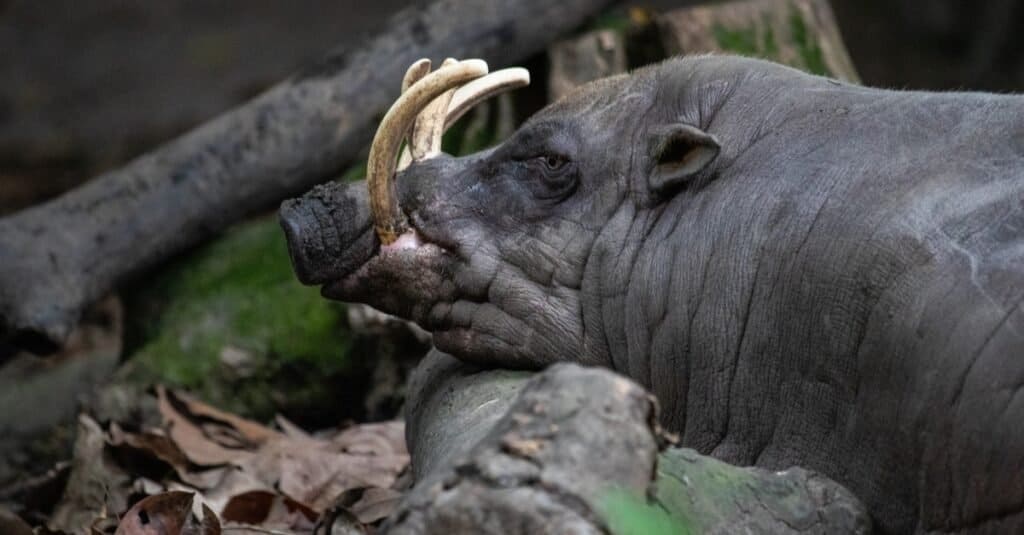
The male babirusa’s upper tusks erupt from its snout.
©tomava/Shutterstock.com
The babirusa is a type of pig that’s found in the forests and canebrakes near bodies of water of Sulawesi and the Moluccas in Indonesia. It has a piglike body, though its legs are long and thin. The hide of the North Sulawesi babirusa is often wrinkled or folded, and its color ranges from brown, gray to brown to black with a few bristles. On the other hand, the golden babirusa has long golden, black or white fur. The Togian babirusa also has lush fur, but it’s a bit shorter.
The babirusa is about 33 to 43 inches long with a 7.9-to-12.6-inch tail and stands 27 to 31.5 inches high at the shoulder. They weigh between 94.7 to 220 pounds. Boars are bigger than sows.
The Weird Tusks of the Male Babirusa
The one notable characteristic of these eight-letter animals is the tusks of the male. The female’s tusks are small or even nonexistent, but his grow from his upper jaw, actually erupt through the skin of his snout, and curve back toward his forehead and even toward his eyes. Because of this, the boars keep their tusks manageable by grinding them on trees. The tusks in his lower jaw also grow, but not as spectacularly. Interestingly, the upper tusks are loose and easily broken. Some biologists believe they protect the boar’s face from the tougher lower tusks when boars spar over females.
Females are pregnant for about 153 days and give birth to one or at most two piglets. This is unusual for pigs, who often give birth to several babies at a time. However, the female babirusa has only one pair of teats. The piglet can eat solid foods within a fortnight of its birth and sometimes after as little as three days, and it’s weaned when it is six to eight months old. Females live with other females and their young, while males are usually solitary.
Babirusas are omnivorous, but their diet is mostly fruit, leaves, and mushrooms, though they will also take animal protein. Because the babirusa lacks a bone in its nose, it doesn’t use its snout to dig for food.
7. Lorikeet
Lorikeets are a tribe of wondrously colorful small parrots native to Australasia. There are 15 lorikeet genera with about 40 species. Lorikeets are very closely related to other colorful parrots called lories, but their tails are usually longer.
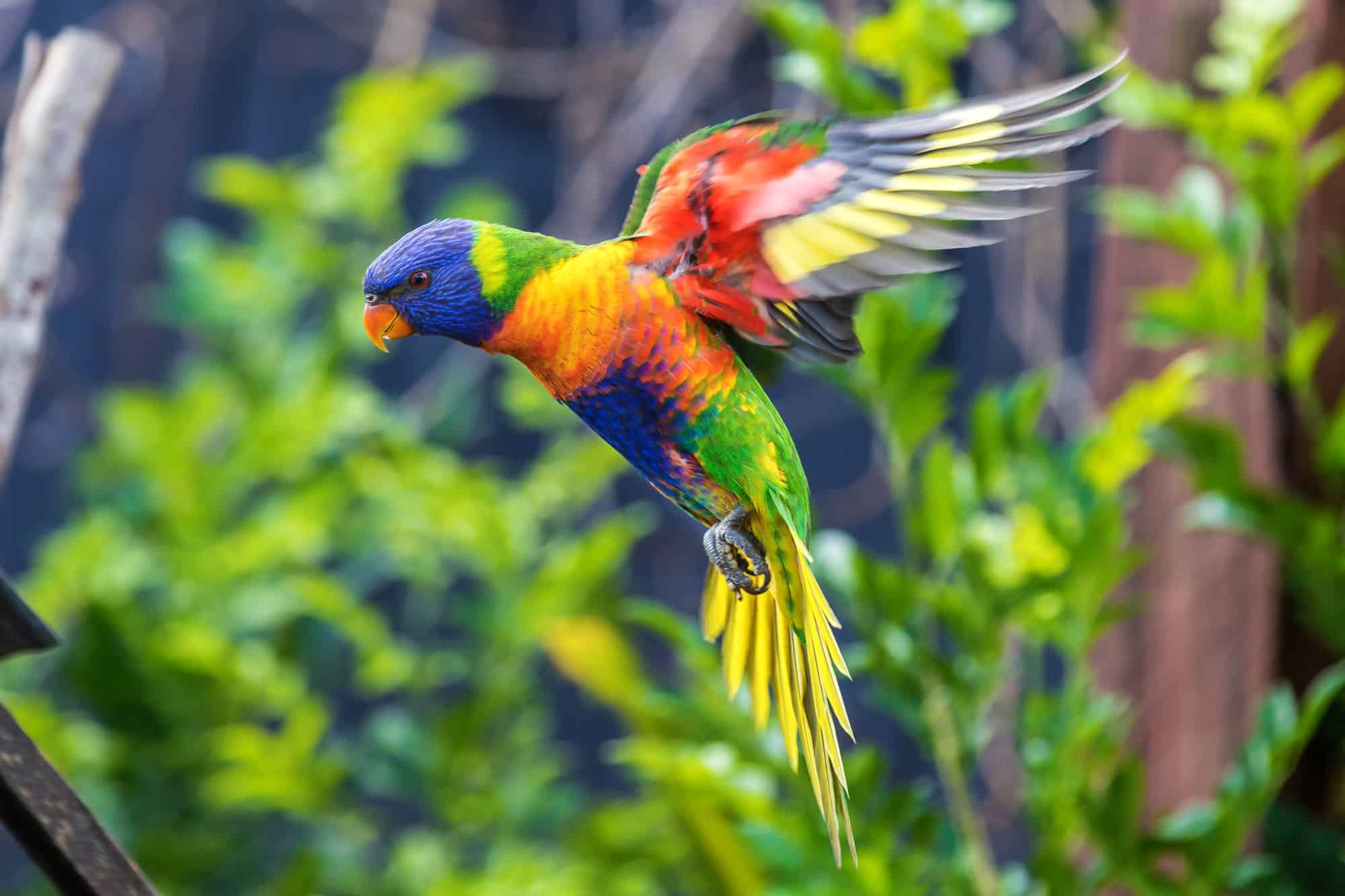
Some species of these resplendant eight-letter animals are endangered.
©Guillem Lopez Borras/Shutterstock.com
One unusual characteristic of these eight-letter animals is their tongue, which has a tip made brush like by tiny filaments. This helps them eat soft fruit and the pollen and nectar of the many types of flowers they visit. Now and then they’ll eat meat if it’s offered. They also love to visit bird feeders.
Because they are so beautiful, lorikeets are targets of the illegal pet trade. This, along with deforestation and predation by non-native animals, puts some species under threat. One endangered bird is the ultramarine lorikeet. Now critically endangered, this lorikeet is one of the rarest birds on earth. It lives only in the mountain forests on the Marquesas Islands, specifically on Ua Huka. There are only between 1,000 and 2,499 of these birds left. The bird gets its name from the brilliant, deep blue plumage of the male. Though the female is also colorful, with a grass-green back, she’s not as startling as the male.
The Blue and the Musk
Another endangered lorikeet is the astonishingly beautiful blue lorikeet, which has lustrous violet-blue feathers with a pure white bib, an orange beak, and orange legs. It’s found in French Polynesia and now is also found in the Cook Islands. This little bird is only about 7 inches long, and it’s unusual in that its tail is short for a lorikeet. Like other lorikeets, it mostly eats nectar and pollen, this time from coconut palms and beach mulberry. They’ll also eat insects that they find.
Other lorikeets include the musk lorikeet which is the only species in the Glossopsitta genus. it lives in south central to eastern Australia. It’s about 8.7 inches long, has mostly green feathers but has red patches on its cheek and forehead. The very top of the head is blue, and it has a yellow band on each wing. These birds are tough enough to thrive in cities, and they find a steady food source in well-maintained urban trees and plants.
8. Mudpuppy
Mudpuppies are types of salamanders found in the southeastern United States and southeastern Canada. The most well-known and widespread is the common mudpuppy. Like other mudpuppies, it lives its entire life in water and has gills even though it’s an amphibian. Mudpuppies, including the common, belong to the Necturus genus. There are about eight species, though this number is controversial.
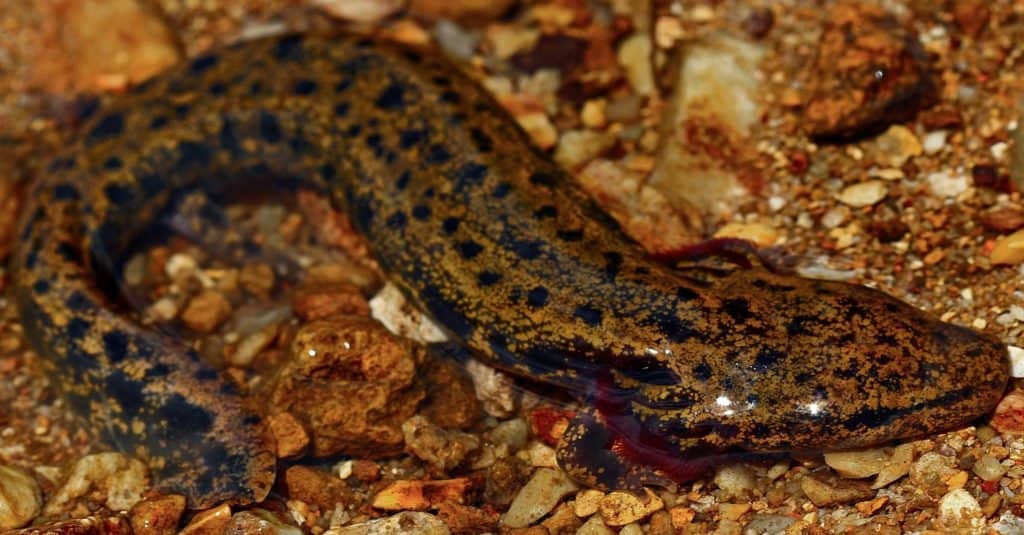
Mudpuppies keep their gills even as adults.
©Peter Paplanus from St. Louis, Missouri / CC BY 2.0, via Wikimedia Commons – Original / License
The mudpuppy lives in fresh, cold, oxygen-rich water where there are plenty of places to find shelter. During the day it’ll rest under fallen logs or rocks or within aquatic weeds. Mudpuppies can live easily in shallow or deep water, and they’ve been found in water that’s nearly 100 feet deep. These eight-letter animals are between 7.9 and 13 inches long and are notable for their large, purplish external gills. The rest of them is gray, brown or black, with black spots and blotches, with a white belly that may also be spotted. The head is flat, and the tail is rudder-shaped to help the animal swim. Each foot, and there are four, have four toes.
Mudpuppies mate in the fall after gathering in shallow waters. Males and females find shelter together, and the male eventually deposits a spermatophore. The female picks it up and tucks it into her cloaca, where she’ll keep it until she’s ready to fertilize her eggs in the spring. When the time comes, she’ll excavate a nest whose opening faces downstream then hang from 18 to 180 eggs from its ceiling. The babies hatch after one to two months, but it takes four to six years before they’re ready to breed themselves. Mudpuppies can live for 20 years.
9. Kinkajou
This carnivore is native to Southern Mexico and down into South America. It looks somewhat like a cross between a monkey and a possum. Indeed, it used to be classed as a primate. The kinkajou has thick, golden brown to dark brow fur, a wide, round head, large, front-facing eyes, a short muzzle, and round ears. Like a possum, it sports a prehensile tail, though its tail is furred. It is strong enough to allow the animal to hang upside down while it feeds. The kinkajou is about 15.5 to 30 inches long, with a 15.5- to 22.5-inch-long tail.
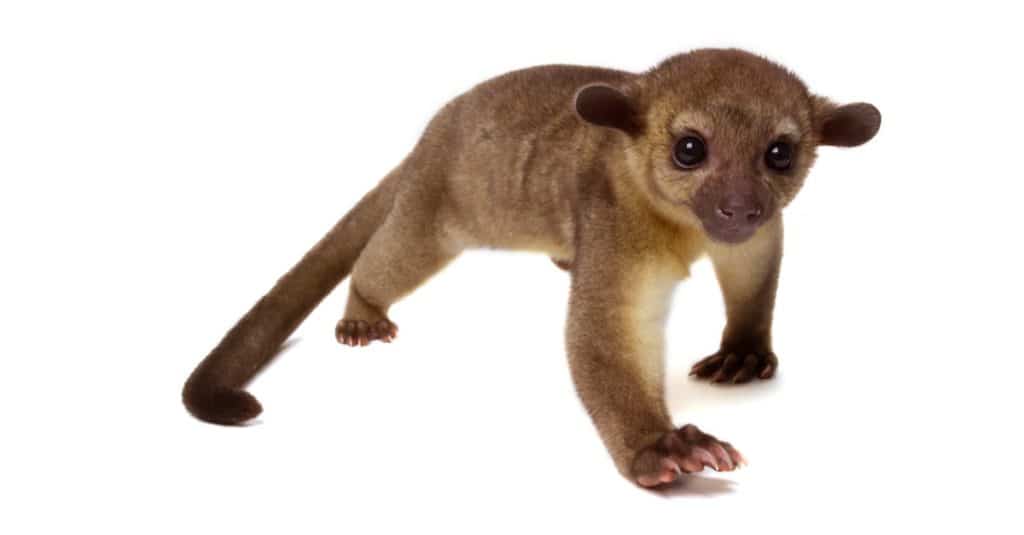
Kinkajous, another of the eight-letter animals, are found from Mexico down to southern Brazil.
©Unknown man/Shutterstock.com
Like a squirrel, the kinkajou can reverse its back feet to climb down trees headfirst. Those feet have naked soles and claws to help it climb back up into the trees where it nests. Its body is also extremely flexible, which makes the kinkajou different from its close cousins. These are neither primates nor possums, but raccoons and coatis. These eight-letter animals are also noisy beasts with a great repertoire of vocalizations. They hiss, scream, snort, bark, squeak, grunt, whistle, and click.
Kinkajou Family Values
The kinkajou has interesting mating habits. A mother, her children, and two males usually form a family group. The dominant male might follow the female for hours, while the subordinate male follows him. Sometimes the two males engage in a fight. Kinkajous can breed all year. The female is in estrus for as long as 17 days, but she’s only ready to mate for two days. She’s pregnant for 98 to 120 days and has one to two pups at a time. The males in the group don’t take care of them but aren’t violent toward them and will sometimes share food. Pups are independent when they’re only four months old. Males are ready to mate when they’re about a year and a half, and females are ready when they’re a little over two years old.
The photo featured at the top of this post is © Ondrej Prosicky/Shutterstock.com
Thank you for reading! Have some feedback for us? Contact the AZ Animals editorial team.







